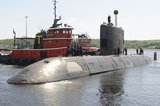HMS Bangor returns to home port
The Royal Navy’s mine hunter HMS Bangor has returned to its home port of HM Naval Base Clyde on 31 August following a three-year deployment in the Gulf.
The Sandown class vessel and Crew 2 from the Faslane-based First Mine Counter Measures Squadron (MCM1) worked alongside US, French, Omani and Kuwaiti allies in the region conducting seabed surveys and on the lookout for maritime mines.
In March the ship joined RFA Cardigan Bay and HMS Ledbury to participate in Khunjar Hadd (Sharp Dagger) which helped test the ability of the navies to work alongside one another.
One of seven Sandown class mine hunters, Bangor is almost entirely made from non-magnetic materials, to counteract the threat from magnetic mines. The class is equipped with the Seafox mine disposal system and a highly-trained team of Royal Navy Clearance Divers who can descend to the seabed to place small explosive charges on ordnance.
More from Naval Warfare
-
![Is the US Navy’s Golden Fleet initiative achievable?]()
Is the US Navy’s Golden Fleet initiative achievable?
The effort to provide the US Navy with Trump-class battleships might face financial, production and doctrinal obstacles.
-
![How will SAFE shape naval procurement for Canada and its highest-receiving members?]()
How will SAFE shape naval procurement for Canada and its highest-receiving members?
Canada’s inclusion on the EU’s Security Action for Europe initiative is set to enhance the country’s defence procurement strategy with important implications for some of its naval programmes, while Poland and Romania have also secured significant SAFE funding.
-
![Thales wins DE&S contract for portable autonomous command centres]()
Thales wins DE&S contract for portable autonomous command centres
The agreement to provide portable autonomous command centres to the UK Royal Navy will enhance the service’s Mine Counter Measure operations and further integrate autonomous and uncrewed systems into its fleet.
-
![US Navy to conduct an experimentation campaign with emerging tech in 2026 and 2027]()
US Navy to conduct an experimentation campaign with emerging tech in 2026 and 2027
The Technology Operational Experimentation Events will inform future requirements as the US Navy looks for innovative solutions across three key operational domains.























